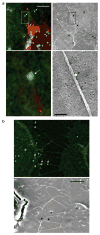Retroviruses can establish filopodial bridges for efficient cell-to-cell transmission
- PMID: 17293854
- PMCID: PMC2628976
- DOI: 10.1038/ncb1544
Retroviruses can establish filopodial bridges for efficient cell-to-cell transmission
Abstract
The spread of retroviruses between cells is estimated to be 2-3 orders of magnitude more efficient when cells can physically interact with each other. The underlying mechanism is largely unknown, but transfer is believed to occur through large-surface interfaces, called virological or infectious synapses. Here, we report the direct visualization of cell-to-cell transmission of retroviruses in living cells. Our results reveal a mechanism of virus transport from infected to non-infected cells, involving thin filopodial bridges. These filopodia originate from non-infected cells and interact, through their tips, with infected cells. A strong association of the viral envelope glycoprotein (Env) in an infected cell with the receptor molecules in a target cell generates a stable bridge. Viruses then move along the outer surface of the filopodial bridge toward the target cell. Our data suggest that retroviruses spread by exploiting an inherent ability of filopodia to transport ligands from cell to cell.
Figures





Comment in
-
Bridging efficient viral infection.Nat Cell Biol. 2007 Mar;9(3):243-4. doi: 10.1038/ncb0307-243. Nat Cell Biol. 2007. PMID: 17330113 No abstract available.
References
-
- Carr JM, Hocking H, Li P, Burrell CJ. Rapid and efficient cell-to-cell transmission of human immunodeficiency virus infection from monocyte-derived macrophages to peripheral blood lymphocytes. Virology. 1999;265:319–329. - PubMed
-
- Igakura T, et al. Spread of HTLV-I between lymphocytes by virus-induced polarization of the cytoskeleton. Science. 2003;299:1713–1716. - PubMed
-
- McDonald D, et al. Recruitment of HIV and its receptors to dendritic cell-T cell junctions. Science. 2003;300:1295–1297. - PubMed
Publication types
MeSH terms
Substances
Grants and funding
LinkOut - more resources
Full Text Sources
Other Literature Sources

